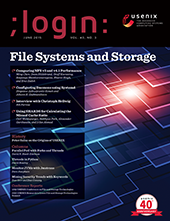USENIX supports diversity, equity, and inclusion and condemns hate and discrimination.
A Tale of Two Concurrencies (Part 1)
;login: Enters a New Phase of Its Evolution
For over 20 years, ;login: has been a print magazine with a digital version; in the two decades previous, it was USENIX’s newsletter, UNIX News. Since its inception 45 years ago, it has served as a medium through which the USENIX community learns about useful tools, research, and events from one another. Beginning in 2021, ;login: will no longer be the formally published print magazine as we’ve known it most recently, but rather reimagined as a digital publication with increased opportunities for interactivity among authors and readers.
Since USENIX became an open access publisher of papers in 2008, ;login: has remained our only content behind a membership paywall. In keeping with our commitment to open access, all ;login: content will be open to everyone when we make this change. However, only USENIX members at the sustainer level or higher, as well as student members, will have exclusive access to the interactivity options. Rik Farrow, the current editor of the magazine, will continue to provide leadership for the overall content offered in ;login:, which will be released via our website on a regular basis throughout the year.
As we plan to launch this new format, we are forming an editorial committee of volunteers from throughout the USENIX community to curate content, meaning that this will be a formally peer-reviewed publication. This new model will increase opportunities for the community to contribute to ;login: and engage with its content. In addition to written articles, we are open to other ideas of what you might want to experience.

Talk to any Python programmer long enough and eventually the topic of concurrent programming will arise—usually followed by some groans, some incoherent mumbling about the dreaded global interpreter lock (GIL), and a request to change the topic. Yet Python continues to be used in a lot of applications that require concurrent operation whether it is a small Web service or full-fledged application. To support concurrency, Python provides both support for threads and coroutines. However, there is often a lot of confusion surrounding both topics. So in the next two installments, we’re going to peel back the covers and take a look at the differences and similarities in the two approaches, with an emphasis on their low-level interaction with the system. The goal is simply to better understand how things work in order to make informed decisions about larger libraries and frameworks.

